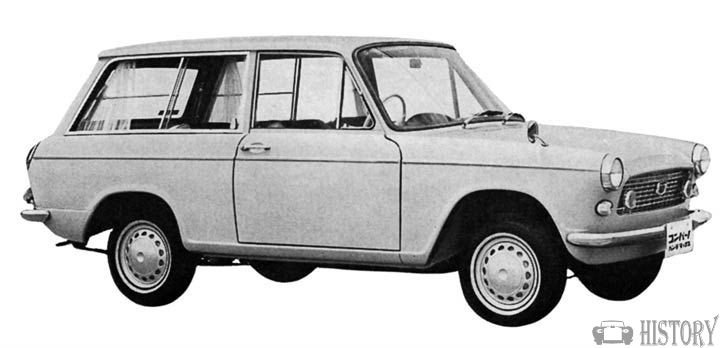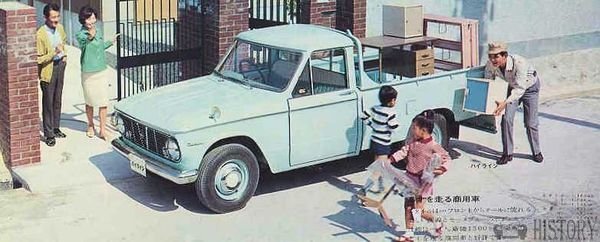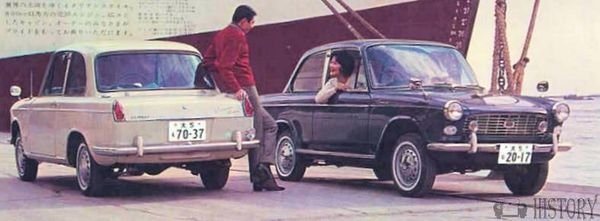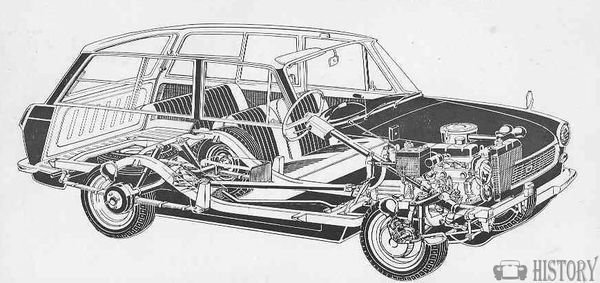Daihatsu Compagno
 |
|
| Manufacturer | Daihatsu |
|---|---|
| Production | 1963 to 1969 |
| Designer | Vignale |
| Class | motor car |
| Body style | 2/4-door sedan 3-door van 2-door pickup truck 2-door cabriolet |
| Layout | Front-engine, rear-wheel-drive |
| Engine | 800 cc FC I4 (petrol) 1000 cc FE I4 ( petrol) |
| Transmission | 4-speed manual 2-speed automatic |
| Wheelbase | 2,220 mm (87.4 in) |
| Length | 3,800 mm (149.6 in) |
| Width | 1,425 mm (56.1 in) |
| Height | 1,430 mm (56.3 in) |
| Curb weight | 765 kg (1,687 lb) |
The Daihatsu Compagno is an automobile produced by Daihatsu in Japan from in the 1960s.
History
The Daihatsu Compagno , called Daihatsu 1000 in Africa , was a passenger car model produced by the Japanese automobile brand Daihatsu between 1963 and 1969. The Compagno was designed to serve in multiple bodystyles, and was introduced prior to the acquisition of Daihatsu by Toyota in 1967.The small car was available with two or four doors as a sedan, two-door as a spider ( cabriolet ) or pickup, or as a station wagon with two doors and a hatchback.
In Europe, where design configurations are most varied in the small-car class a four-seater car weighing 18 cwt, it is unusual for its conventionality.Unlike other small cars of the time such as the Toyota Publica it was not self-supporting chassis but on a ladder frame.The car was powered by a four-stroke petrol engine with overhead valves and four cylinders in line with either 0.8 or 1.0 liters displacement at the front.for 1000 cc models. The more powerful Spider had a fuel injected engine at the front driving the rear wheels
of an all-steel body mounted on a separate chassis frame .For a small car it is very well equipped with transistor radio is standard.
The 797 c.c. engine gives a lively performance in the lower gears without making much noise.The four-speed all-synchromesh gearbox is controlled by column change with Widely spaced ratios.Like the clutch and gearchange, the steering is very light and easy to turn. The Reasonable medium-size boot boot takes 5.7 cu.ft of luggage.The tool kit comes with pliers, two screwdrivers and a spanner.
inside the seats have thick woven cloth upholstery with good heating and ventilation that has three easy controls and also includes an electric windscreen washer, cigar lighter, electric clock, tinted glass all round, ash trays at the back, little push-button radio with semi-automatic aerial, satin-finished stainless steel fittings there is a parcel tray inside a small facia locker and map pockets in the doors and plenty of safety padding on the facia and sun visors.

The Spider was also available with manifold injection , the other versions were only available with carburetors.The power was transmitted to the rear axle via a fully synchronized four-speed manual transmission.The front wheels were individually suspended independent, wishbones, longitudinal torsion bars, anti-roll bar and telescopic dampers, at the rear there was arigid axle, semi-elliptic leaf springs, anti-roll bar and telescopic dampers.Gearbox was mechanical with 4 + reverse gears and single dry plate clutch or 2 speed auto.
PERFORMANCE 800cc
- max power (DIN): 41 hp at 5,000 rpm
- max torque (DIN): 47 1b ft, 6.5 kg m at 3,600 rpm
- max number of engine rpm: 6,000
- power weight ratio: 40.6 lb/hp. 18.4 kg/hp
- Engine Capacity 48.63 cu in, 797 cu cm
- Fuel Consumption 47 mlimp gal, 39.2 mlUS gal, 6 1 x 100 km
- Max Speed 69 mph, 111.1 km/h
The first Compagno prototype was shown at the 1961 Tokyo Motor Show and had a design reminiscent of the Fiat 1800/2100. This was not a very well balanced design and the production version ended up looking quite different. It went on sale in the United Kingdom in 1964 as the first Japanese car to be sold there.

120,000 Daihatsu Compagnos were produced between 1963 and 1970, including:
- 1963–1967 Compagno 800 Van (797 cc 41 hp) three-door van model F30V
- 1963–1967 Compagno 800 (797 cc 41 PS) two-door sedan model F40
- 1965–1967 Compagno Spider 800 (797 cc) cabriolet/convertible model F40K
- 1965–1970 Compagno 1000 (958 cc 55 PS) two or four-door sedan model F40 - later models have 58 PS
- 1965–1970 Compagno 1000 Truck (958 cc 55 PS) two-door pickup truck model F31P
- 1965–1970 Compagno Spider 1000 (958 cc, 65 PS) cabriolet/convertible model F40K

Technical
-
Daihatsu Compagno Technical details and specifications (1963–1969)
ENGINE :800cc
front, 4 stroke; cylinders: 4, vertical, in line
bore and stroke: 2.44 x 2.60 in, 62 x 66 mm
engine capacity: 48.63 cu in, 797 cu cm
compression ratio: 9
specific power: 51.4 hp/l
cylinder block: cast iron; cylinder head: light alloy
crankshaft bearings: 3
valves: 2 per cylinder, overhead, in line, push-rods and rockers
camshafts: 1, side
lubrication: gear pump, full flow filter
lubricating system capacity: 5.28 imp pt, 6.34 US pt, 3 1
carburation: 1 Solex downdraught single barrel carburettor
fuel feed: mechanical pump
cooling system: waterENGINE :1000cc
front 4, stroke cylinders: 4, vertical, in line
bore and stroke: 2.68 x 2.60 in, 68 x 66 mm
engine capacity: 58.58 cu in, 960 cu cm
compression ratio: 9
cylinder block: cast iron
cylinder head: light alloy
crankshaft bearings: 3
valves: 2 per cylinder, overhead, in line, push-rods and rockers
camshafts: 1, side
lubrication: gear pump, full flow filter
lubricating system capacity: 5.28 imp pt, 6.34 US pt, 3 1
carburation: 1 Stromberg downdraught twin barrel carburettor
fuel feed: mechanical pump; cooling system: water
cooling system capacity: 8.10 imp pt, 9.72 US ptTRANSMISSION
driving wheels: rear
clutch: single dry plate
gearbox: mechanical; gears: 4 + reverse
final drive: hypoid bevel
axle ratio: 5.125.CHASSIS
box-type ladder frame
front suspension: independent, wishbones, longitudinal torsion bars, anti-roll bar, telescopic dampers
rear suspension: rigid axle, semi-elliptic leafsprings, anti-roll bar, telescopic dampers.STEERING
recirculating ball
turns of steering wheel lock to lock: 2.50.
turning circle (between walls): 29,5 ft, 9 mBRAKES
drum.ELECTRICAL EQUIPMENT
voltage: 12 V
battery: 29 Ah
alternator: 200 W
ignition distributor: Nippon-DensoDIMENSIONS AND WEIGHT Saloon
wheel base: 87.40 in, 2,220 mm
front track: 46.46 in, 1,180 mm
rear track: 45.67 in, 1,160 mm
overall length: 149.61 in, 3,800 mm
overall width: 56.89 in, 1,445 mm
overall height: 55.51 in, 1,410 mm
ground clearance: 6.30 in, 160 mm
dry weight: 1,665 1b, 755 kg© Motor car History
Service
-
Daihatsu Compagno Practical Instructions and Service Guide (1963–1969)
ENGINE :800cc
fuel: 90-95 oct petrol
engine oil: 4.9 imp pt, 5.92 US pt, 2.8 1
cooling system capacity: 7.57 imp pt, 9.09 US pt, 4.3 1.
tyre pressure (medium load): front 20 psi, 1.4 atm, rear 2 psi, atm.
tyres: 5.20 x 12
fuel tank capacity: 7.48 imp pt. 8.98 US pt, 34 1.
carrying capacity saloon: 882 1b, 400 kg
carrying capacity spider: 706 1b, 320 kg.© Motor car History
